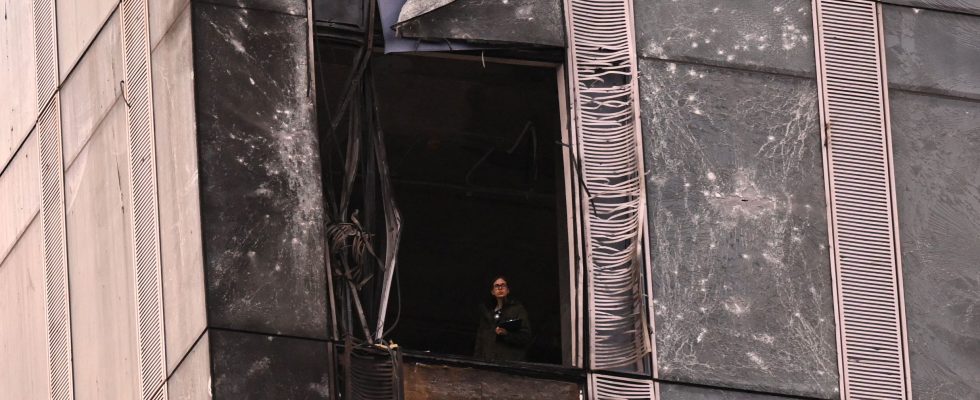On August 17, a Ukrainian drone crashed very close to houses in the Russian village of Nikolskoe, in the Belgorod region. Fourteen kilometers further west is already Ukraine and, further, the city of Kharkiv. Retired, Tatiana lives in one of the last houses in the village – right on the route of Ukrainian drones heading towards Moscow, 600 kilometers further east. “I heard the device explode, it’s scary but we shouldn’t panic. I continue to live,” she says while clearing the weeds around her flowers. This former professor who has family in Ukraine fell out with her when she tried to explain to them that “the truth is on our side”. She is convinced, “they fight for money, we for the homeland”.
Further away, another retiree has difficulty containing his anger: “The people who live near the border are abandoned, he fumes. We see the drones passing above us and it has become commonplace, as if that was going to last. And it’s not on TV that you’re going to learn the truth!”
In Belgorod, the regional capital, the war was heard until now, but not seen. “Every evening, at 11 p.m., the explosions start again,” says Yaroslav, in his twenties. But the proliferation of drones, launched from Ukrainian territory, has made the danger more real. “There was one who fell at the end of the street last week. The explosion damaged a building. Fortunately there were no victims! It’s scary, but I prefer not to think,” he confides. The young man does not want to take a stand. He appears to support Vladimir Putin, but presents the war as an unexplained event.
Signal cut
For the Russian army, everything depends on the first ten kilometers. Air defense systems and jammers manage to eliminate the majority of threats. But when the drones are sent in swarms, some manage to cross the net and head towards the capital. They still have to survive the many obstacles – hills, woods, towers and power cables. In the interest of discretion and efficiency, the Ukrainians cut off the drone signal a few minutes after their launch to put them on automatic pilot. They only regain control a few kilometers from the target.
kyiv dreams of shaking up the Russians by confronting them with war using its drones. But collective apathy, born from the exclusion of the population from political matters, still seems to dominate. Often launched between 1 a.m. and 4 a.m., drones generally reach their targets before 7 a.m. and almost never cause casualties. Heavy-sleeping Russians will only hear about these attacks – systematically “shot down by air defense” – by reading the news pages of their newspapers…
To reach their targets, sometimes far from its border, the Ukrainians use cunning. They designed their own machine, the “Beaver”. It can carry out suicide missions up to more than 600 kilometers away. At the end of August, kyiv also managed to attack a military airfield in Kursk with Australian drones… made of cardboard. These only cost 3,000 euros to design and can travel up to 150 kilometers on a small charge. Advantage, they carry almost no metal, which makes them almost undetectable by Russian radars.
But Ukrainian drones also reach the capital. Several times they hit the business district of Moscow. And once, a building adjacent to the Ministry of Defense. They are sometimes suspected of heading towards a closed neighborhood in which all the Moscow elite, the Rublevka, live. In rare cases, they have affected apartment buildings. In Russia, the subject must not become one. Unlike Ukraine, there is no question of launching sirens to alert the population. After each attack, the authorities work to make the damage disappear as quickly as possible.
Russian general dismissed
On August 22, Dasha, 26, was woken up at dawn by a large explosion. The young woman lives in a shared apartment in the suburbs of Moscow, in the city of Krasnogorsk. At first she thought it was fireworks. Before you panic. “A drone crashed into a nearby building. I saw a big yellow light, then a loud noise I had never heard before,” she says. In his videos sent to his acquaintances a few minutes after the explosion, we can hear him, panting, emergency vehicles in the background. She comes across neighbors who come down from their homes and crowd around, curious, shocked and furious, until the emergency services come to ensure that no explosive charge no longer threatens the residents. Dasha films and listens to her neighbors’ reactions.
“One of them told the public that he wanted all Ukrainians to die,” she says. “I reacted by telling him that we should not wish for people to die. He told me accused me of being pro-Ukrainian and advised me to be discreet, adding that the enemy was everywhere around him… I would have liked to answer, but it would be too dangerous. There are plenty of degenerates like him in my neighborhood.” That day, the drone caused no injuries. Only a few dozen windows were broken and several cars damaged. The only victim of these repeated attacks on the capital may well have been the major general responsible for protecting the city. On September 6, Konstantin Ogienko was dismissed from his post. Officially, for accepting a bribe.
